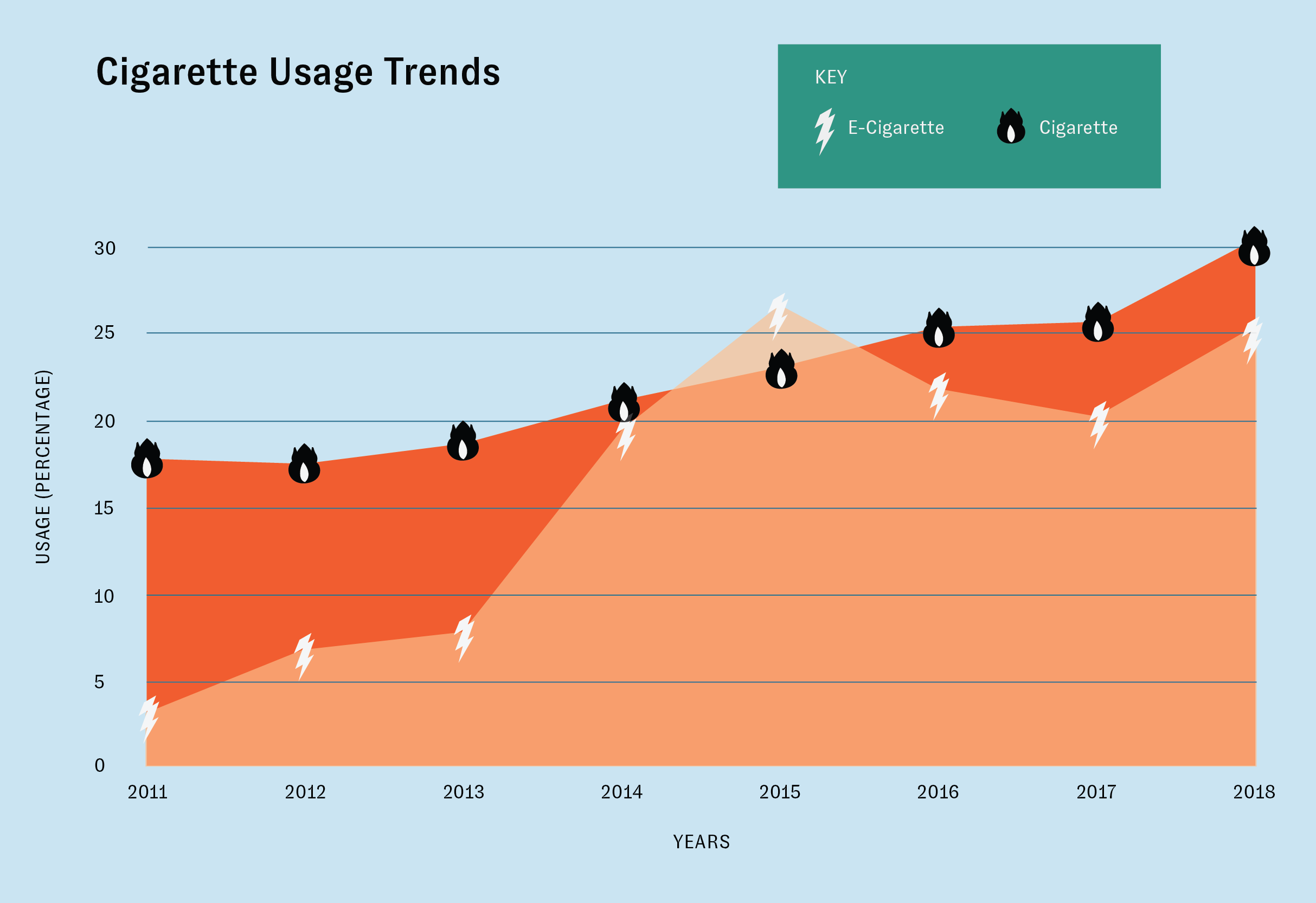Five decades ago, restaurants, parks, and schools were shrouded in a cloud of smoke, and U.S. Surgeon General Luther Terry was trying to see through the haze. To find a meaningful way to investigate and convey the dangers of smoking, he created the Advisory Committee on Smoking and Health, whose 1964 report concluded that cigarette smoking was a cause of cancer and chronic illness. Thanks to his efforts, Congress took action the following year and passed the Federal Cigarette Labeling and Advertising Act of 1965. Five years later, the bill had evolved into the Public Health Cigarette Smoking Act of 1969 (PHCSA), and President Richard Nixon signed it into law.
Nearly fifty years after Nixon’s stamp of approval banned tobacco companies from running advertisements in television and radio media, another health threat is on the rise. E-cigarettes are becoming increasingly popular, especially among young people. Between 2017 and 2018, the percentage of U.S. high school students who reported using an e-cigarette in the prior 30 days nearly doubled. Respiratory disease linked to over 500 cases of lung injury and at least six deaths in the U.S. has brought e-cigs to the forefront once again.
Even as e-cigs appear to be a new threat, many of the same tobacco companies targeted by the original PHCSA are involved. Altria, Marlboro’s parent company, owns a sizeable 35 percent stake in Juul, one of the country’s most popular e-cigarettes. Likewise, competitor Philip Morris is designing its own e-cig product. These tactics seem to work; research has shown that e-cigarette use is associated with the adoption of cigarette smoking. By marketing e-cigarettes on television, especially to teens, major players in the tobacco industry have effectively found a way to circumvent PHCSA.
Given the similarities between e-cigarettes and traditional cigarettes, as well as the recent spike in vaping-induced illness, it seems obvious that the solution is simply to pass an addendum extending the PHCSA to include e-cigs. However, even as President Trump himself has called for a ban on flavored e-cigarette pods, the more moderate question of banning e-cigarette advertisements has been curiously absent from discussion. An examination of recent challenges to the PHCSA helps elucidate this gap in the debate.
After the PHCSA became law, two developments threatened the legal and political conditions that made its passage possible. First, in May 1976, the Supreme Court ruled in Virginia Pharmacy Board v. Virginia Consumer Council that purely commercial speech was protected under the First Amendment. Though Justice Harry Blackmun argued in his majority opinion that misleading, false, or illegal speech could still be regulated, the case dealt a severe blow to the constitutional underpinnings that allowed for the PHCSA’s passage. If that were not enough, the FCC revoked its Fairness Doctrine rule in 1987. The Fairness Doctrine required that broadcasting licensees must discuss issues pertaining to the public interest in a balanced way. With the tide of deregulation surging in the 1980s, enforcement of the rule fell by the wayside, and it was officially axed from FCC regulations in 2011. In the wake of these developments, pushing to amend or expand PHCSA could jeopardize its status as law; such a battle could lead to a court challenge that may all too realistically result in the total repeal of the PHCSA.
Despite these complications, it isn’t entirely clear that the logic Justice Blackmun used to argue for the protection of commercial speech in 1976 can be applied to the modern market for e-cigarettes. One of the major points of the majority decision in the case was that “both the individual consumer and society in general may have strong interests in the free flow of commercial information.” However, given Big Tobacco’s inclination toward misinforming consumers to pad their pockets, an argument can be made that present e-cigarette advertising actually inhibits that free flow of information. Moreover, despite traditional Republican opposition to government regulation of markets, President Trump is, at least for the moment, squarely on the anti-vape side of the debate. His support makes passage of a legal expansion of the PHCSA more plausible, given that the idea would face minimal White House resistance.
Even in the event that a PHCSA expansion fails to become law, a solution may already exist within PHCSA itself. The bill outlaws the sale of cigarettes that do not explicitly identify their nicotine content. Interestingly, smoking cessation products such as nicotine gum must also list their nicotine contents. In other words, these smoking cessation products are subject to the same kinds of regulation as tobacco products. Thus, it seems perfectly reasonable to claim that e-cigarettes, which similarly must disclose their nicotine contents, may also be subject to control under the PHCSA.
Outside the public policy realm, private businesses are already adopting strict standards on e-cigarette advertising. In early September, CNN announced that it would no longer allow Juul and other e-cigarette makers to run ads on the network. Although the announcement came with the caveat that they would reconsider if new facts came to light, CNN’s actions provide a glimmer of hope that television networks will take it upon themselves to stop allowing e-cig manufacturers to mislead consumers.
Whether e-cigarette advertising is restricted by government regulation, or self-regulated by networks hesitant to promote dangerous substances to their viewers, a change is sorely needed. While e-cig manufacturers need to market their product to make it commercially viable, the prevention of deceptive e-cigarette advertising ought to take precedence. Allowing these advertisements to continue without a balanced warning is an obvious threat to public safety. By doing nothing, the American people allow Big Tobacco to perpetuate its smoke and mirrors ad campaigns in an attempt to save their industry at the expense of consumers’ health.
Infographic by Madi Ko ’21, data by Prakrit Baruah ’20
